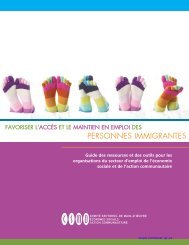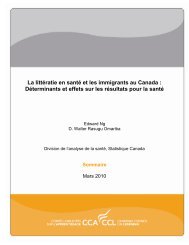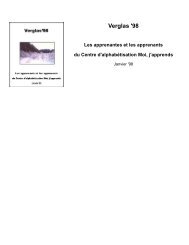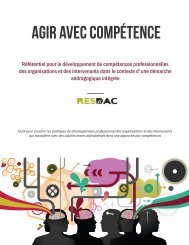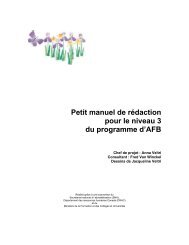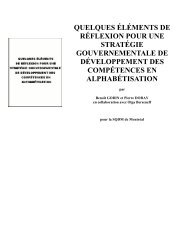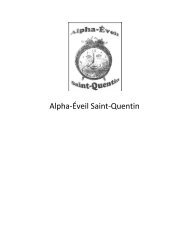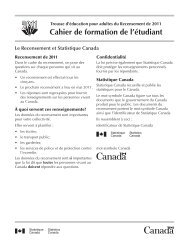Les pratiques et défis de l'évaluation en ligne - Base de données en ...
Les pratiques et défis de l'évaluation en ligne - Base de données en ...
Les pratiques et défis de l'évaluation en ligne - Base de données en ...
Create successful ePaper yourself
Turn your PDF publications into a flip-book with our unique Google optimized e-Paper software.
TABLE DES MATIÈRESSommaire ........................................................................................................................................................... 2Remerciem<strong>en</strong>ts .................................................................................................................................................. 5Introduction ........................................................................................................................................................ 6Chapitre 1. Des facteurs <strong>de</strong> développem<strong>en</strong>t .............................................................................................. 81,1 UN CONTEXTE FAVORABLE .............................................................................................................................. 81,2 UNE PÉDAGOGIE DE L‟ÉVALUATION ................................................................................................................. 91,21 <strong>Les</strong> objectifs d’appr<strong>en</strong>tissage .............................................................................................................. 91,22 <strong>Les</strong> compét<strong>en</strong>ces évaluées ................................................................................................................. 91,23 La finalité <strong>de</strong>s évaluations .................................................................................................................. 101,24 La rétroaction ....................................................................................................................................... 111,25 <strong>Les</strong> activités réalisées ......................................................................................................................... 111,26 La fréqu<strong>en</strong>ce <strong>de</strong> la mesure ................................................................................................................ 141,27 <strong>Les</strong> évaluateurs .................................................................................................................................... 141,28 <strong>Les</strong> critères d’évaluation ..................................................................................................................... 151,29 La portée ............................................................................................................................................... 151,3 VERS UN ALIGNEMENT ................................................................................................................................... 16EN RÉSUMÉ : DES EXERCICES SUR LES FACTEURS DE DÉVELOPPEMENT DE L‟ÉVALUATION EN LIGNE ................. 19Chapitre 2. Des <strong>pratiques</strong> <strong>et</strong> modèles d’évaluation ..................................................................................... 222,1 DES ÉVALUATIONS ENTIÈREMENT EN LIGNE ................................................................................................. 232,11 <strong>Les</strong> questionnaires automatisés ........................................................................................................ 242,12 <strong>Les</strong> simulations .................................................................................................................................... 332,2 DES ACTIVITÉS D‟ÉVALUATION EN LIGNE ...................................................................................................... 352,21 <strong>Les</strong> forums <strong>et</strong> autres échanges <strong>en</strong> <strong>ligne</strong> .......................................................................................... 362,22 <strong>Les</strong> cyberportfolios .............................................................................................................................. 382,23 D’autres activités sur le Web ............................................................................................................. 412,3 LE SOUTIEN À L‟ÉVALUATION ........................................................................................................................ 462,31 L’amélioration <strong>de</strong> la rétroaction ......................................................................................................... 462,32 Le suivi <strong>de</strong>s traces ............................................................................................................................... 472,33 L’analyse <strong>et</strong> la correction <strong>de</strong> textes .................................................................................................. 482,4 DES APPROCHES INTÉGRÉES ........................................................................................................................ 49EN RÉSUMÉ : DES EXERCICES SUR LES PRATIQUES D‟ÉVALUATION EN LIGNE ....................................................... 50Chapitre 3. Le défi du plagiat ......................................................................................................................... 533,1 LE PHÉNOMÈNE DU PLAGIAT .......................................................................................................................... 533,11 <strong>Les</strong> types <strong>de</strong> malhonnêt<strong>et</strong>é scolaire <strong>et</strong> <strong>de</strong> plagiat .......................................................................... 533,12 La préval<strong>en</strong>ce <strong>de</strong> la malhonnêt<strong>et</strong>é scolaire ..................................................................................... 553,13 <strong>Les</strong> causes évoquées ......................................................................................................................... 593,2 LES MESURES POUR FAVORISER L‟INTÉGRITÉ .............................................................................................. 653,21 La prév<strong>en</strong>tion........................................................................................................................................ 653,22 La formation.......................................................................................................................................... 673,23 L’adaptation <strong>de</strong> l’évaluation <strong>et</strong> <strong>de</strong> l’<strong>en</strong>cadrem<strong>en</strong>t............................................................................ 693,24 La détection .......................................................................................................................................... 723,25 La sanction ........................................................................................................................................... 74EN RÉSUMÉ : DES EXERCICES SUR LE PLAGIAT ET LA MALHONNÊTETÉ SCOLAIRE ................................................ 78Chapitre 4. Des avantages <strong>et</strong> d’autres <strong>défis</strong> ................................................................................................. 824,1 DES AVANTAGES ET DÉFIS COMMUNS ........................................................................................................... 824,2 DES AVANTAGES ET DÉFIS PARTICULIERS ..................................................................................................... 854,21 <strong>Les</strong> évaluations <strong>en</strong>tièrem<strong>en</strong>t automatisées ..................................................................................... 854,22 <strong>Les</strong> autres évaluations <strong>en</strong> <strong>ligne</strong> ......................................................................................................... 87EN RÉSUMÉ : DES EXERCICES SUR LES AVANTAGES ET DÉFIS DE L‟ÉVALUATION EN LIGNE .................................. 90Conclusion ....................................................................................................................................................... 92ANNEXE : Un inv<strong>en</strong>taire <strong>de</strong> logiciels <strong>et</strong> d’outils ........................................................................................... 94A) Des logiciels <strong>et</strong> outils pour l’évaluation ............................................................................................... 94B) Des logiciels <strong>et</strong> outils <strong>de</strong> détection du plagiat <strong>et</strong> <strong>de</strong> la tricherie ..................................................... 101Bibliographie .................................................................................................................................................. 104



